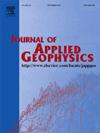结合最优输运和最小二乘距离的井间探地雷达全波形反演
IF 2.2
3区 地球科学
Q2 GEOSCIENCES, MULTIDISCIPLINARY
引用次数: 0
摘要
如果初始模型不够接近全局最小值,使用最小二乘距离的基于梯度的全波形反演将收敛到局部最小值。在本文中,我们提出了一种独立于初始模型的井间探地雷达层析成像全波形反演算法。这是通过使用最佳传输距离来实现的,该距离具有一个广泛的全局最小值,而对于普通探地雷达全波形反演问题几乎没有局部最小值。由于计算最优传输距离在计算上是昂贵的,并且最优传输距离的广泛全局最小值受到最优解附近数值近似的影响,我们提出了一种算法,该算法仅在反演的前几次迭代中使用最优传输距离,并在找到足够接近真实解的解时切换到最小二乘距离。该算法的另一个特点是使用随机主点集和随后的插值来稀疏和显式地计算梯度。这避免了天线位置附近的高灵敏度,这妨碍了在这些区域进行有意义的模型更新。此外,该方法平滑了梯度,从而使模型在目标函数中没有显式的模型正则化项。最后,显式地计算梯度可以方便地实现其他距离度量,因为不需要更新梯度计算。由于梯度的显式计算可以并行进行,并且只需要有限数量的主点,因此额外的计算成本是有限的。我们在一个简单的合成数据集上展示了该算法的能力,表明所提出的算法在我们的示例数据集上比只使用最小二乘或最优传输距离的情况下工作得更好。本文章由计算机程序翻译,如有差异,请以英文原文为准。
Crosshole ground-penetrating radar full-waveform inversion by combining optimal-transport and least-squares distances
Gradient-based full-waveform inversion using the least-squares distance converges to a local minimum if the starting model is not close enough to the global minimum. In this article, we propose a full-waveform inversion algorithm for crosshole ground penetrating radar tomography that is independent of the starting model. This is achieved by using an optimal-transport distance, which features one broad global minimum and almost no local minima for common ground penetrating radar full-waveform inversion problems. As calculating an optimal-transport distance is computationally expensive and as the broad global minimum of the optimal-transport distance is impacted by numerical approximations in the vicinity of the optimal solution, we propose an algorithm that uses the optimal-transport distance only in the first few iterations of the inversion and switches to the least-squares distance once a solution close enough to the true solution has been found. An additional feature of the proposed algorithm is the sparse and explicit calculation of the gradient using random sets of master points and subsequent interpolation. This avoids the high sensitivity close to the antenna locations, which prohibits meaningful model updates in these regions. Furthermore, this approach smooths the gradient and, thus, the model without an explicit model-regularization term in the objective function. Finally, calculating the gradient explicitly allows to easily implement other distance measures as no update of the gradient calculation becomes necessary. As the explicit calculation of the gradient can be done in parallel and only a limited number of master points is necessary, the additional computational cost is limited. We demonstrate the capabilities of the algorithm on a simple synthetic dataset showing that the proposed algorithm works much better on our example dataset than if only least-squares or optimal-transport distances are used.
求助全文
通过发布文献求助,成功后即可免费获取论文全文。
去求助
来源期刊

Journal of Applied Geophysics
地学-地球科学综合
CiteScore
3.60
自引率
10.00%
发文量
274
审稿时长
4 months
期刊介绍:
The Journal of Applied Geophysics with its key objective of responding to pertinent and timely needs, places particular emphasis on methodological developments and innovative applications of geophysical techniques for addressing environmental, engineering, and hydrological problems. Related topical research in exploration geophysics and in soil and rock physics is also covered by the Journal of Applied Geophysics.
 求助内容:
求助内容: 应助结果提醒方式:
应助结果提醒方式:


